Shed Hunting
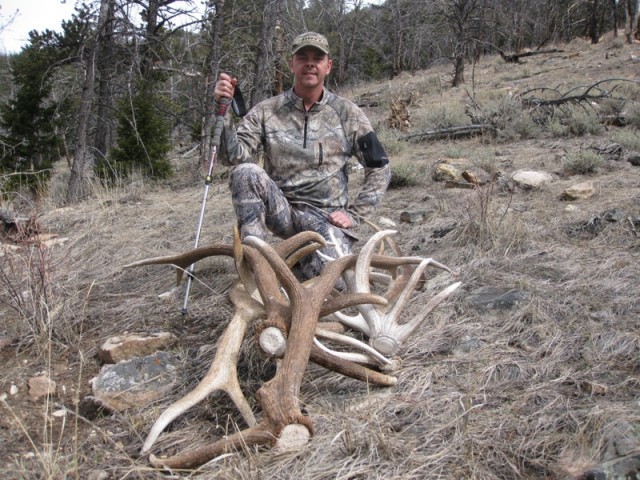 April 2nd, 2011, was one of my best days shed hunting for elk antlers, also probably one of the most physically demanding days I’ve ever spent in the mountains. I went with my buddy Isaac, and we found over 20 elk sheds, 14 of which were worth keeping. About five miles into our hike, we stashed 6 of them for horse packing or another backpacking trip at a later date. Throughout the rest of the day we found 8 more and brought them out on our pack frames. Considering our average elk antler weighs about 10 pounds, it makes for quite a load. The day started with beautiful weather, but by eleven in the morning it was snowing sideways, typical spring weather in Wyoming. It could have been dangerous if we weren’t prepared with the right clothing. March and April, the key months for shed hunting can be brutal and unforgivable, especially at an elevation of 8000-9000 feet.
April 2nd, 2011, was one of my best days shed hunting for elk antlers, also probably one of the most physically demanding days I’ve ever spent in the mountains. I went with my buddy Isaac, and we found over 20 elk sheds, 14 of which were worth keeping. About five miles into our hike, we stashed 6 of them for horse packing or another backpacking trip at a later date. Throughout the rest of the day we found 8 more and brought them out on our pack frames. Considering our average elk antler weighs about 10 pounds, it makes for quite a load. The day started with beautiful weather, but by eleven in the morning it was snowing sideways, typical spring weather in Wyoming. It could have been dangerous if we weren’t prepared with the right clothing. March and April, the key months for shed hunting can be brutal and unforgivable, especially at an elevation of 8000-9000 feet.
Shed antler hunting is growing in popularity nationwide. Many whitetail hunters use shed hunting to scout for next year’s potential harvest. As an avid elk hunter, I do the same. Many places in the west have migratory herds, so finding a great pair of shed antlers doesn’t necessarily mean that bull will be within 50 miles the following fall. Regardless, it is great exercise and can be a good way gain further knowledge about your elk unit or other ones. I find shed hunting a great cure for spring fever after a long winter.
Things to remember
The number one rule before beginning your antler hunting adventure is to be sure of the state regulations about gathering or keeping them. Since shed antler hunting has become extremely popular and competitive over the past few years, a few people have taken it to the extreme. This has led some states to take action. Some states now have actual antler hunting seasons, some have certain opening dates and some may restrict it altogether. Also remember to do your research and use your GPS and maps to make sure you don’t trespass on any private lands or parks.
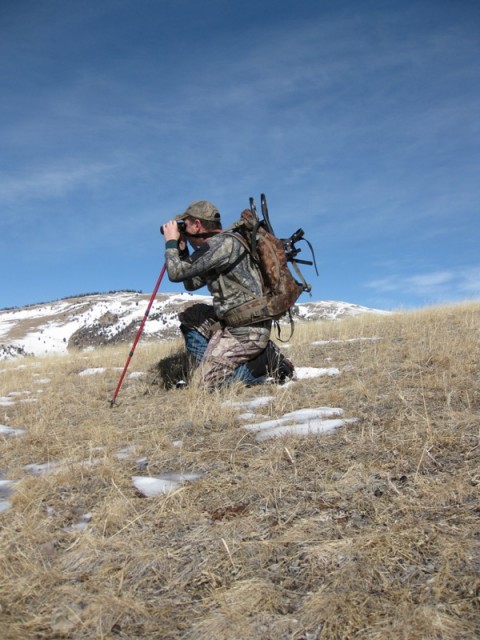 The second rule I would like to mention is ethics: (Don’t disturb the elk)! Typically late winter and early spring is a critical time for elk survival. When time is getting close for elk to be dropping antlers, I like to find a vantage point early in the morning where I can put my optics to work. It’s better to spot bulls from a distance using binoculars or a spotting scope to see where they’ve been feeding and if any are missing antlers. If you are patient and wait for the bulls to timber-up and bed for the day, you can then go search the clearings where they’ve fed for the night, pick up whatever antlers are there without disturbing the bulls. If you remain patient, sometimes you can do this several days/weeks in a row. Lord knows in many areas, wolves harass the elk enough; they don’t need us adding to their pressure at this critical time of year. Be careful and try not to disturb them.
The second rule I would like to mention is ethics: (Don’t disturb the elk)! Typically late winter and early spring is a critical time for elk survival. When time is getting close for elk to be dropping antlers, I like to find a vantage point early in the morning where I can put my optics to work. It’s better to spot bulls from a distance using binoculars or a spotting scope to see where they’ve been feeding and if any are missing antlers. If you are patient and wait for the bulls to timber-up and bed for the day, you can then go search the clearings where they’ve fed for the night, pick up whatever antlers are there without disturbing the bulls. If you remain patient, sometimes you can do this several days/weeks in a row. Lord knows in many areas, wolves harass the elk enough; they don’t need us adding to their pressure at this critical time of year. Be careful and try not to disturb them.
In some areas of the west antler hunting may not very physically demanding. In northwest Wyoming it is! After my fall hunting seasons end, I keep myself in shape, looking forward to the middle of March when I begin to look for antlers. Staying in shape for me consists of hiking and snowshoeing, looking for mountain lion tracks, all the while searching out wind-blown ridges where bulls may spend the winter. I do this as much as possible from December through February. Bottom line is, just like your fall hunting season, you should be physically prepared as well as have some areas scouted out.
Equipment and clothing
If you are serious about antler hunting, a sturdy pack frame is a necessity. Smaller day packs might be easier to maneuver with and be more comfortable, but try strapping 50 pounds of antlers to a daypack and hiking around. 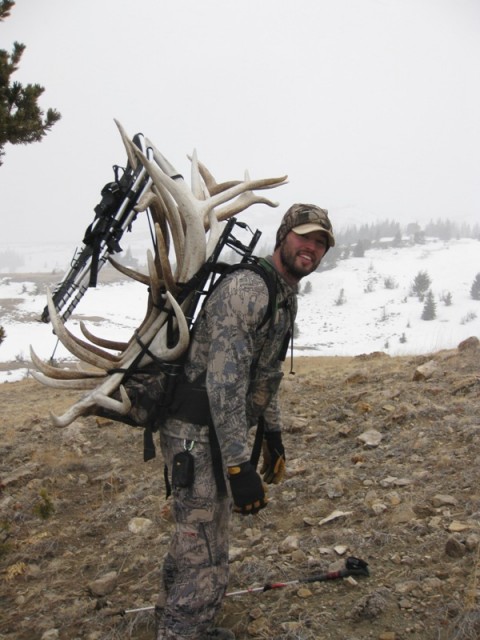 From past experience, I can tell you it is NOT comfortable. I carry bungee cords instead of rope. Bungees are easier and faster to strap a load on and quicker to rearrange when you have to add more antlers. Nothing is worse than working on rope knots with cold fingers. Use the lightweight cord type bungees instead of the heavy rubber straps.
From past experience, I can tell you it is NOT comfortable. I carry bungee cords instead of rope. Bungees are easier and faster to strap a load on and quicker to rearrange when you have to add more antlers. Nothing is worse than working on rope knots with cold fingers. Use the lightweight cord type bungees instead of the heavy rubber straps.
For clothing, I would recommend wearing your typical hunting attire. Personally I wear clothes by Sitka Gear during fall hunts, all spring while antler hunting and basically any other time of the year I am out hiking. Sitka is unbeatable for comfort, durability and safety. Do not wear cotton clothing unless you are out in late spring or early summer and aren’t worried about the weather! If Isaac and I had been wearing cotton on our trip, we would have become hypothermic very quickly and been in a dangerous situation.
Another must is a good set of gaiters. Sitka, Outdoor Research or Kenetrek make the best. Using a walking stick or two is a huge advantage and increases your safety as well. Use a store bought model, or make your own out of lightweight wood. On steep hills, in snow or carrying a load, they are a huge help.
The bulls in my area typically spend the winters up high, solo or in bachelor groups. They like the high, wind blown ridges and unless pressured by wolves or people, will scratch out a living there all winter long. Very rarely will you find bulls with cows after November and if you do, they will usually be smaller type bulls. The earliest I have ever found a shed elk antler is March 1st. Typically, mid-March is when they begin shedding, and it usually peaks around the first week of April. This year I found one large matched set of 7 point antlers on March 11th. Larger, more mature bulls tend to shed first, with some smaller rag horn bulls carrying their antlers well into April.
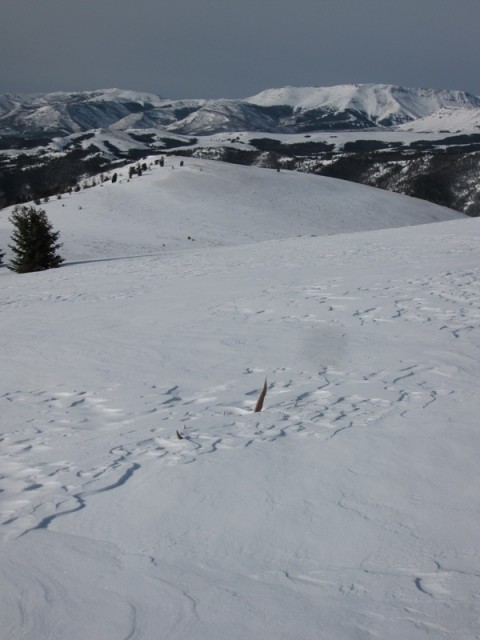 Just getting to the ridges where the bulls winter can be a strenuous ordeal. Snow conditions usually dictate where a person can or can’t go. It’s almost impossible to ascend a north facing slope in the spring. Downed timber and deep powder snow make climbing those slopes dangerous and almost impossible. Snowshoes are almost always on my pack but are reserved for crusty snow conditions. Nothing will wear you out faster than post-holing through thigh or waist deep snow. It’s worth packing snowshoes for 10 miles even if you only have to use them for a few hundred yards. This past weekend, snow conditions were so soft that even with snowshoes, we were waist deep in snow. We ended up crawling with snowshoes on our hands several times to make it across really deep places.
Just getting to the ridges where the bulls winter can be a strenuous ordeal. Snow conditions usually dictate where a person can or can’t go. It’s almost impossible to ascend a north facing slope in the spring. Downed timber and deep powder snow make climbing those slopes dangerous and almost impossible. Snowshoes are almost always on my pack but are reserved for crusty snow conditions. Nothing will wear you out faster than post-holing through thigh or waist deep snow. It’s worth packing snowshoes for 10 miles even if you only have to use them for a few hundred yards. This past weekend, snow conditions were so soft that even with snowshoes, we were waist deep in snow. We ended up crawling with snowshoes on our hands several times to make it across really deep places.
Finding antlers
Just like with hunting, where you never look for an entire animal, while antler hunting, don’t look for an entire antler. You are basically just scanning for anything out of the ordinary. Year-old white antlers are incredibly easy to see. The fresh brown ones can be extremely difficult, even when out in the open. The shape and sometimes the ivory tipped points can give their location away. Do not overlook snowy areas, even if there are no tracks. Snow conditions change and fresh wind blown snow can make it look like no animal has been there all winter. Sometimes all you might see is a point or two from an antler sticking up. I use binoculars extensively and scan everything in sight. An antler lying in plain sight may be difficult to see from as little as 200 yards. Binoculars tend to make them really stand out. Get a reference mark before lowering your binoculars! It’s easy to lose track of where you were looking.
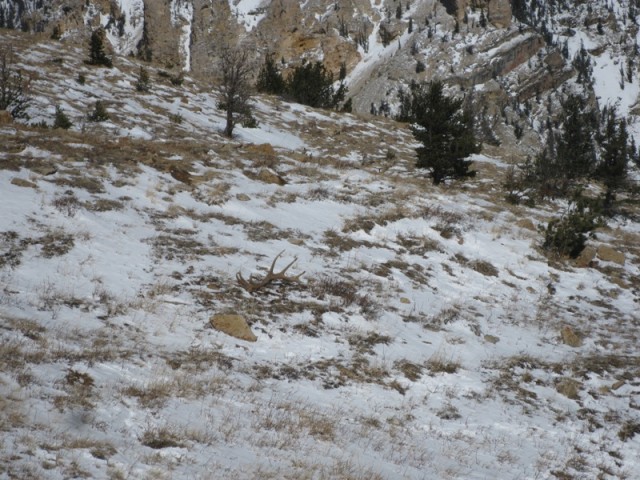 Look over as much open terrain as possible; don’t miss the easy ones. When in the trees, walk slowly and look for bull sign. Tracks, beds, droppings and rubs are all good indicators you are in a good area. In deep snow conditions, bulls will often hang out near the bases of trees where the canopy has lessened the snow depth. Windblown ridges and south facing slopes are key places, especially if there is adjoining timber. If there are cliffs on a south facing slope, pay close attention right at the base of the cliffs. I’ve keyed in on these areas for the past few years with good results. I think the sun against the rock backdrop creates more warmth for the bulls, and fresh green grass sprouts early there as well. Take your time and use a grid search pattern where you can. If there is good bull sign, don’t give up without covering the area well. Some friends key in on fresh tracks in the snow. They will follow the tracks like a bird dog looking for the bulls antlers.
Look over as much open terrain as possible; don’t miss the easy ones. When in the trees, walk slowly and look for bull sign. Tracks, beds, droppings and rubs are all good indicators you are in a good area. In deep snow conditions, bulls will often hang out near the bases of trees where the canopy has lessened the snow depth. Windblown ridges and south facing slopes are key places, especially if there is adjoining timber. If there are cliffs on a south facing slope, pay close attention right at the base of the cliffs. I’ve keyed in on these areas for the past few years with good results. I think the sun against the rock backdrop creates more warmth for the bulls, and fresh green grass sprouts early there as well. Take your time and use a grid search pattern where you can. If there is good bull sign, don’t give up without covering the area well. Some friends key in on fresh tracks in the snow. They will follow the tracks like a bird dog looking for the bulls antlers.
If you are into horseback riding, hunting antlers can be a great way to spend the spring days; however springtime riding in the mountains can be very dangerous. Slippery mud and icy slopes can lead to horse accidents. A few years ago we lost a local young man when his horse went down and rolled over him on an icy slope. Be extremely careful where you ride and look into the special horseshoes specifically for that type of riding.
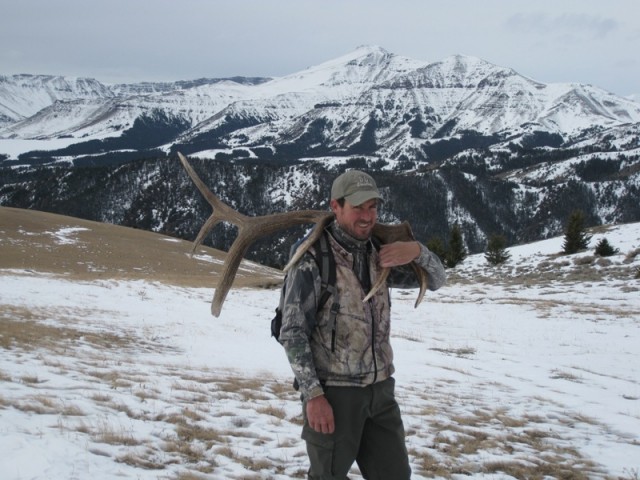 Finally, always carry a camera with you and keep it in your pocket or another easy place to access. When you are tired, it’s difficult to make yourself dig out a camera for pictures so keep it accessible. Try to take pictures of each antler before picking it up. Then if you can, have a buddy take some of them strapped on your back. Those pictures are just as fun to look back on as hunting pictures are. Go prepared, have fun and good luck. In any case, enjoy your time in the field and again, please remember to not put undo stress on the elk.
Finally, always carry a camera with you and keep it in your pocket or another easy place to access. When you are tired, it’s difficult to make yourself dig out a camera for pictures so keep it accessible. Try to take pictures of each antler before picking it up. Then if you can, have a buddy take some of them strapped on your back. Those pictures are just as fun to look back on as hunting pictures are. Go prepared, have fun and good luck. In any case, enjoy your time in the field and again, please remember to not put undo stress on the elk.
